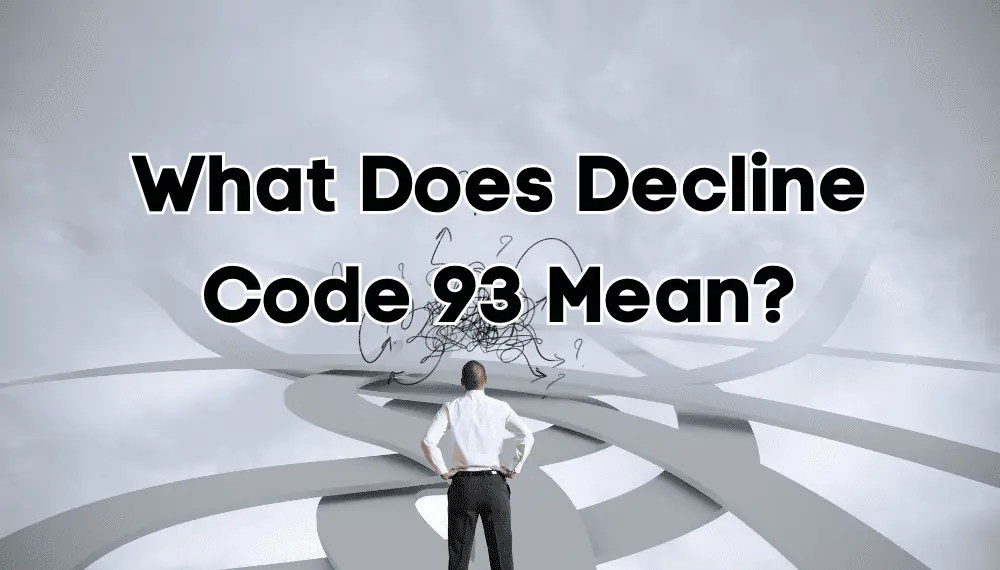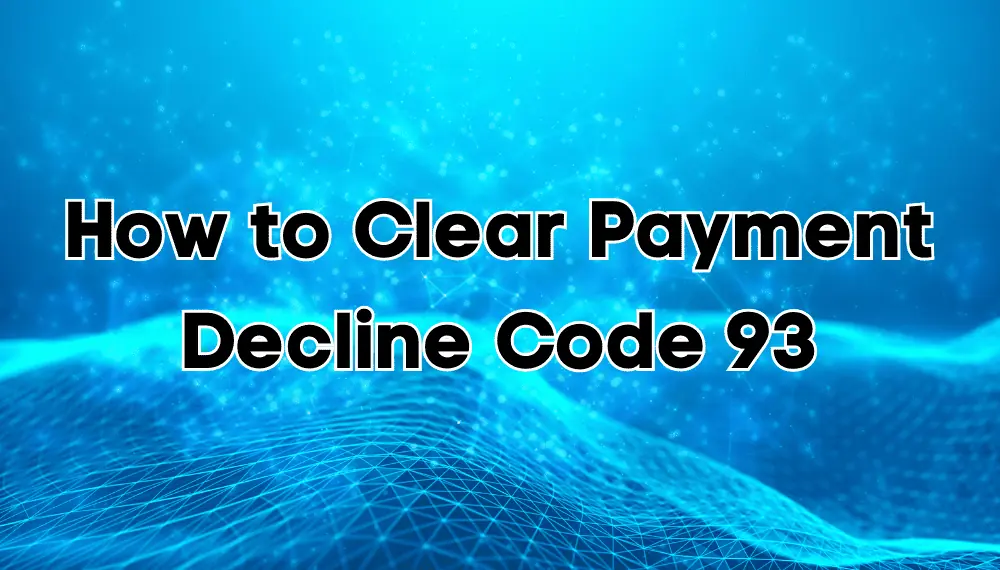Imagine you’ve just made a purchase using your trusty credit card, only to be met with an unexpected and frustrating message – “Transaction Declined: Code 93.” As a business owner or someone who frequently deals with electronic payments, you may have encountered this mysterious code more than once. This article will unravel the secrets of the Decline Code 93, clarifying its meaning and providing you with actionable steps to navigate this roadblock. So, let’s dive into the world of payment declines and arm ourselves with the knowledge needed to handle the Decline Code 93.
What is a Decline Code?
A decline code is a numerical or alphanumeric representation that surfaces when a customer’s transaction cannot be processed successfully. It serves as a coded explanation for the merchant, shedding light on the specific problem that led to the decline. These codes can manifest for various reasons, encompassing a range of issues such as insufficient funds, suspicious or fraudulent activity detected by the payment processor, expired credit or debit cards, or even technical glitches in the payment system.
Understanding decline codes is crucial for merchants, as they offer valuable insights into the root cause of transaction failures, allowing businesses to address and resolve issues promptly. Armed with this knowledge, merchants can take appropriate actions to enhance transaction success rates and provide smoother payment experiences for their customers.
What Does Decline Code 93 Mean?

Decline Code 93, often seen in credit or debit card transactions, carries the meaning of “Violation, Cannot Complete.” When this code surfaces, it signifies that the customer’s card-issuing bank is unable to finalize the transaction for specific reasons. In essence, the bank is signaling a violation that prevents the successful completion of the payment. However, the code does not explicitly state the exact cause of the violation, leaving merchants and customers in a state of uncertainty.
To resolve this issue and proceed with the transaction, the customer is advised to contact their bank directly for further information and clarification. This step is crucial, as it allows the customer to address any potential concerns or restrictions imposed by their bank, thereby increasing the likelihood of a successful future transaction. For merchants, understanding the implications of Decline Code 93 and guiding customers through the necessary steps for resolution can lead to improved payment processing and enhanced customer satisfaction.
Reasons Decline Code 93 Can Occur

Decline Code 93, also known as “Violation, Cannot Complete,” is a payment decline code that can occur for various reasons during credit or debit card transactions. It signifies that the customer’s card-issuing bank has encountered an issue preventing them from completing the transaction successfully. While the specific reasons for this decline may vary based on the bank’s policies and security measures, several common factors contribute to the occurrence of Decline Code 93.
Security Violations
One of the most prevalent reasons for Decline Code 93 is the detection of a potential security violation by the card-issuing bank. This could involve suspicious activity on the card, such as multiple high-value transactions in a short period or transactions from geographically distant locations. To protect their customers from fraud and unauthorized use, banks might block these transactions until they receive further validation from the cardholder.
Insufficient Funds
Insufficient funds in the customer’s account is another common cause of Decline Code 93. When the cardholder attempts a transaction that exceeds their available credit or account balance, the bank will decline the transaction to prevent the account from going into a negative balance.
Account Holds and Restrictions
Card-issuing banks may place temporary holds or restrictions on accounts for various reasons. This can occur if the bank suspects unusual account activity, if the cardholder has reported their card as lost or stolen, or if the account is in arrears. Such holds can lead to a decline of any transaction until the issue is resolved.
Expired or Inactive Cards
Decline Code 93 may occur if the card being used has expired or if it is no longer active. In such cases, the bank will reject the transaction as the card is no longer valid for use.
Technical Glitches
Occasionally, technical glitches in the payment processing systems can lead to Decline Code 93. These glitches may arise from connectivity issues between the merchant’s terminal and the bank’s authorization system, resulting in a failure to complete the transaction.
Exceeding Transaction Limits
Banks often impose transaction limits to protect customers from large unauthorized charges. If a transaction surpasses these predefined limits, the bank might decline it until the cardholder contacts them to authorize the transaction.
Merchant Category Code (MCC) Restrictions
Some banks impose restrictions on specific merchant categories to mitigate risks associated with certain industries. If a transaction falls within a restricted MCC, it may trigger Decline Code 93.
Payment Processor Errors
In rare instances, the payment processor handling the transaction may experience technical issues or inaccuracies, leading to the decline.
To address Decline Code 93 and facilitate a successful transaction, the cardholder should contact their bank’s customer service immediately. By reaching out to the bank, customers can verify their identity, resolve any security concerns, update their account information, or address any other issues preventing the completion of the transaction. Similarly, merchants can guide their customers through this process, offering assistance and ensuring a smooth payment experience.
Overall, while Decline Code 93 signals a failure to complete a transaction, understanding the potential reasons behind it enables both cardholders and merchants to take the necessary steps for resolution. By addressing these underlying issues, businesses can minimize transaction declines and foster positive customer relationships while also upholding security measures to protect against fraudulent activities.
Steps to Fix Decline Code 93
When encountering Decline Code 93, it can be frustrating for both customers and merchants. However, there are steps that can be taken to resolve the issue and complete the transaction successfully. Here’s a guide on how to fix Decline Code 93:
Inform the Customer
If the customer is present during the transaction, politely inform them that their payment has been declined and provide them with the specific reason, which is “Violation, Cannot Complete.” Let them know that this issue can be resolved and it is a common occurrence that can happen to anyone.
Ask for an Alternative Payment Method
If the customer has another payment card, you can suggest trying a different card. Sometimes, the issue may be specific to one card, and an alternative card could work without any problems.
Verify Customer Details
Ensure the customer has entered all the payment details accurately, including the card number, expiration date, CVV code, and billing address. A simple typo in any of these details can lead to a decline.
Contact the Card-Issuing Bank
If the customer is present, they can directly contact their card-issuing bank using the customer service number printed on the back of their card. Alternatively, the customer can access their online banking portal to check for any security alerts, account holds, or transaction restrictions.
Clear Outstanding Dues
If the decline is due to insufficient funds, the customer should check their account balance and ensure that there are enough funds available for the transaction.
Verify Card Expiry Date
In case of an expired card, the customer needs to use a valid card for the transaction.
Resolve Account Holds
If there are any holds or restrictions on the customer’s account, the bank’s customer service can assist in lifting them once the customer’s identity and account ownership are verified.
Update Card Information
If the customer’s card information has changed (e.g., due to a reissued card after loss or theft), they should update the new card details with the bank and use the updated card for the transaction.
Check MCC Restrictions
Merchants can verify if the transaction falls under any restricted Merchant Category Code (MCC) set by the card-issuing bank. If so, customers may need to use an alternative payment method or contact their bank to allow the specific transaction.
Try Again Later
Sometimes, temporary technical issues with the payment processor or the bank’s systems can cause a decline. In such cases, it is often beneficial to wait for a few minutes and attempt the transaction again.
Remember, it is essential to handle declined transactions with professionalism and empathy towards the customer. Assure them that these issues are common and can be easily resolved. Encourage customers to reach out to their banks to get to the root of the problem and facilitate a smoother payment process in the future. For merchants, being proactive in assisting customers during such situations can enhance the overall shopping experience and build customer trust and loyalty.
How Can Businesses Deal with Decline Code 93

Dealing with Decline Code 93 requires a proactive approach from businesses to ensure smooth payment processing and positive customer experiences. Here are some strategies for businesses to handle Decline Code 93 effectively:
Train Staff on Decline Codes
Educate your staff, especially those handling payment transactions, about decline codes and their meanings. This will enable them to explain the issue to customers professionally and provide appropriate guidance.
Notify Customers of Decline
If possible, set up real-time notifications for declined transactions. Inform the customer immediately and discreetly about the decline, allowing them to take necessary actions promptly.
Encourage Alternative Payment Methods
Offer customers multiple payment options, including credit/debit cards from different issuers, mobile wallets, or other electronic payment methods. This way, if one card is declined, the customer can use an alternative without any inconvenience.
Provide Customer Support
Train your customer support team to handle decline code issues empathetically and efficiently. Have them guide customers on what to do next and how to resolve the decline.
Display Error Messages Appropriately
If you have an online store or payment portal, ensure that error messages are clear and user-friendly. Avoid displaying the exact decline code but provide a helpful message instructing customers to contact their bank for assistance.
Check for Technical Issues
Regularly monitor your payment processing systems for any technical glitches that may cause declines. Address these issues promptly to reduce the likelihood of Decline Code 93 occurrences.
Offer Retry Option
If the decline is due to a temporary issue, consider implementing a retry option for customers. For instance, you can prompt them to try the transaction again after a short interval.
Implement Fraud Prevention Measures
Implement robust fraud detection and prevention mechanisms to minimize the risk of unauthorized transactions, which can lead to Decline Code 93.
Update Card Information Promptly
If you have recurring billing or subscription services, remind customers to update their card information when they receive a new card to avoid potential declines.
Maintain Customer Records
Keep track of declined transactions and customer interactions related to Decline Code 93. This data can help identify patterns or recurring issues and assist in finding effective solutions.
Communicate with Payment Processors and Banks
Establish a good working relationship with your payment processors and banks. In case of recurring decline issues, collaborate with them to find root causes and work together on potential solutions.
Monitor Decline Rates
Regularly analyze decline rates to identify trends and potential problem areas. Take proactive steps to reduce decline rates and improve transaction success.
By employing these strategies, businesses can effectively deal with Decline Code 93 and minimize its impact on their operations and customer satisfaction. Prompt and helpful customer support, along with a focus on fraud prevention and technical reliability, can go a long way in ensuring smoother payment processing and a positive overall customer experience.
Final Words
In conclusion, understanding and addressing Decline Code 93 is essential for businesses that accept credit and debit card payments. This enigmatic code, signifying “Violation, Cannot Complete,” can occur due to various reasons, such as security violations, insufficient funds, card expiration, or technical glitches.
However, by implementing proactive measures, businesses can navigate these hurdles smoothly and ensure successful payment processing for their customers. Educating staff on decline codes, offering multiple payment options, providing excellent customer support, and maintaining robust fraud prevention measures are just a few steps businesses can take to handle Decline Code 93 effectively.
By prioritizing customer satisfaction and transaction security, businesses can build trust, loyalty, and a reputation for seamless payment experiences. Furthermore, open communication and collaboration with payment processors and banks can aid in identifying and resolving recurring issues, leading to improved transaction success rates and a more efficient payment ecosystem overall. Ultimately, by staying proactive and informed, businesses can overcome the challenges presented by Decline Code 93 and foster a thriving and customer-centric payment environment.
Frequently Asked Questions (FAQs)
Why did my card get declined with Code 93?
Decline Code 93 can occur due to various reasons, including suspected fraud or security violations, insufficient funds, expired or inactive cards, account holds, and technical glitches.
How can I fix Decline Code 93?
To resolve Decline Code 93, customers should contact their card-issuing bank to understand the specific issue and follow the bank's instructions to resolve it. They may need to verify their identity, clear outstanding dues, or update their card information.
Can I use another card if my transaction is declined with Code 93?
Yes, if your transaction is declined with Code 93, you can try using an alternative payment card if available. Sometimes, the decline may be specific to a particular card, and another card might work without any issues.
I have sufficient funds, why did my transaction still get declined with Code 93?
Besides insufficient funds, Decline Code 93 can occur due to various security-related reasons, including suspected fraudulent activity, account holds, or restrictions imposed by the card-issuing bank. Contacting the bank for clarification can help resolve the issue.
Is Decline Code 93 a permanent issue?
No, Decline Code 93 is not a permanent issue. It is a temporary decline that can be resolved once the underlying problem is addressed. Customers can usually resolve the decline by contacting their bank and following the necessary steps.
Can merchants retry a transaction after a Code 93 decline?
Merchants can offer customers the option to retry the transaction after a Code 93 decline, especially if the decline was due to a temporary issue. However, it is essential to avoid excessive retry attempts, as this may raise suspicion of fraudulent activity.
Are there any transaction limits associated with Code 93 declines?
Yes, some card-issuing banks impose transaction limits to prevent large unauthorized charges. If a transaction exceeds the predefined limits, it may trigger a Decline Code 93. Customers can contact their bank to authorize the specific transaction if required.

